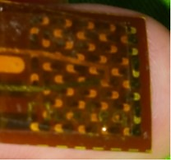Technology and Scientific Platform
Over the past decade, Thermoperfusion has developed and refined a proprietary perfusion monitoring technology built around a thermal sensing platform.
What is Perfusion?
What is Perfusion?

Perfusion is essential for maintaining healthy tissue and organs. Perfusion (blood flow per unit volume of tissue) is the body’s instrument for transporting essential nutrients, oxygen, waste products, and temperature to and from internal organs.
Insufficient blood flow (ischemia) can stress tissue viability leading to cellular dysfunction, organ failure, and cell death. Excessive blood flow (hyperemia) can lead to edema, again stressing the viability of functionality of tissue.
Why Thermoperfusion?
Why Thermoperfusion?
Thermoperfusion has developed a unique thermal sensing platform that utilizes heat transfer principles and proprietary algorithms to non-invasively monitor tissue perfusion, local temperature, core body temperature, and thermal resistance.
Easy to use
Thermoperfusion provides a simple solution to monitor perfusion and more.
Custom Design
Thermoperfusion's technology is agile and able to adapt to meet the needs of our clients.
Reliable, Consistent, and Quantifiable metrics
Thermoperfusion thermal sensing platform is founded on fundamental engineering laws, ensuring dependable results.
Affordable pricing
Thermoperfusion is offering a licensable patent and our in-house expertise to help our clients realize their vision.

A small, thin, flexible sensor that was designed for and equipped with Thermoperfusion technology
(sensor shown resting on fingertip).
How Does It Work?
How Does It Work?
Place a Thermoperfusion sensor onto the target area(s). Once in position, the sensor can be activated for monitoring.
While the sensor is actively monitoring, a brief, low-amplitude thermal event (heating or cooling) is generated to create a thermal differential at the target location. Temperature and heat flux are measured and incorporated into a proprietary algorithm to compute the local perfusion, core-temperature, and thermal contact resistance (R-value).
